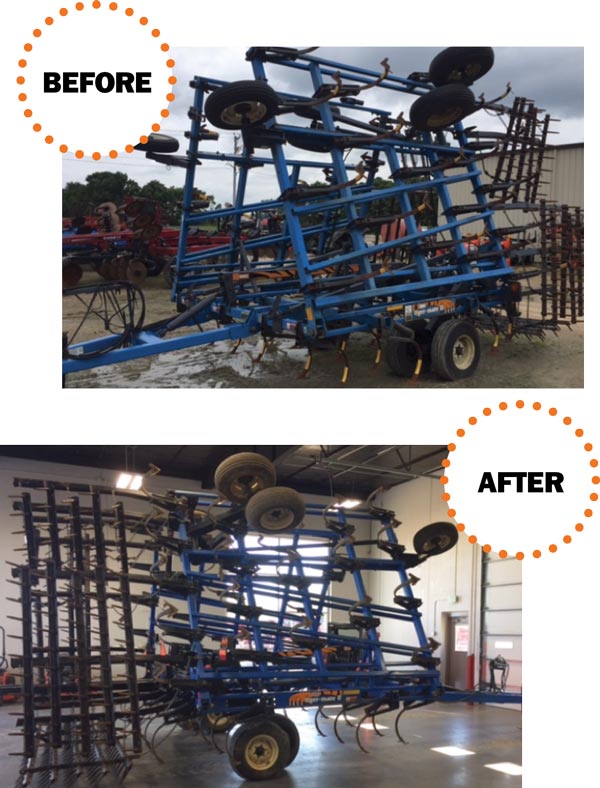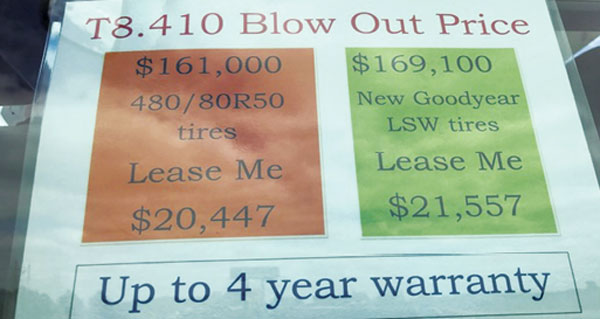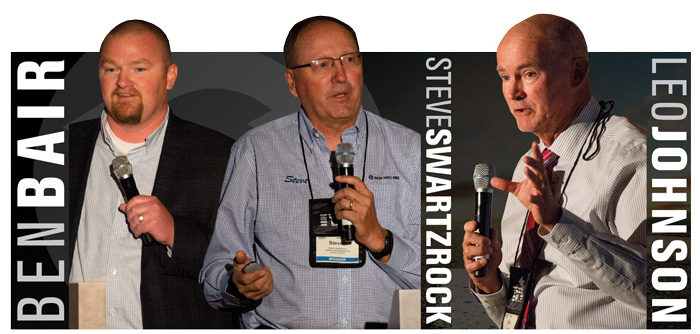The following article is based on Ben Bair, Steve Swartzrock and Leo Johnson's presentation at the 2017 Dealership Minds Summit. To watch the presentation, click here.
Equipment might get old, but smooth trade-ins at maximum margins never go out of style. With little question about the pitfalls of leaving used machines on the lot too long, dealers tuned in to learn the good, the bad and the ugly of equipment turnover strategies.
In an expert dealer panel presentation that included Ben Bair of Pape Machinery, Steve Swartzrock of Swartzrock Implement Co. (2005 Farm Equipment Best In-Class Dealership) and Leo Johnson of Johnson Tractor (2012 Farm Equipment Dealership of the Year), the strategies weren’t always universal, but one key concept stood true: If dealerships aren’t willing to put in the prep work, they might as well take their trade-ins straight to auction.
Market First, Price Second
For success in turning over used equipment at maximum value, Bair says the process needs to begin far before the actual trade-in is complete. Waiting until after a machine is exchanged is often too late in the game to get a worthwhile sale. Referring to trade-ins as “ticking time bombs,” Bair likens the preparation process for turnover to that of a 3-legged stool, in which three key factors are dependent upon each other for success: market research, appropriate pricing of the unit and the timeline for making the sale. Without each “leg” standing strong, the sale is unlikely to hold up.
While a salesperson might say value and pricing are the most important aspects involving a trade, Bair believes pricing a machine without adequate research on the market is an uphill, unnecessary battle. Market size and quality of the machine must be considered, but for dealerships that are serious about understanding demand, the process is just getting started.
“We need to profile the buyer of the trade,” Bair says. “If we’re going to trade for this piece of equipment, then who’s going to buy it, what does that guy look like? What type of buyer is he and how many of those buyers are out there?”
By categorizing the different types of customers (retail, second tier retail, wholesale and auction) and pinpointing the typical purchaser for a given machine, Bair says dealerships can be confident in how aggressively it can be priced.
From there, he says dealers should evaluate the current economy, analyzing how quotes, inquiries and previous sales results have been affected as a result. When executed properly and in the correct order, Bair says machines will be priced appropriately more often than not.
Just as important as understanding the market for pricing is the rate at which it happens. For Bair, setting the goal of selling a trade-in between 30-60 days not only minimizes the deterioration of value on the machine, but also establishes an efficient philosophy in which sales, service and management can help avoid procrastination.
“If we’re going to wait until next planting, tillage or harvest season, then it’s more difficult to determine that price,” he says. “I’m not a big believer in waiting on the seasons of the product. If something is priced correctly and you understand the market, it will turn quickly.”
What Sells & What Doesn’t?
Swartzrock also chimed in on the need to study the market, more specifically the benefits of real-time online auction platforms for his dealership’s turnover strategy. By utilizing sites like Tractor House, Fastline and Machinery Pete to search the highest and lowest prices on specific models (and discover how many farmers or dealerships are interested in buying or selling), he says the dealership can build a foundation of pricing and marketing strategies.
Swartzrock notes an example with the New Holland TH390, where two models in nearly identical condition were in question: one for $233,000 and another for $141,000. In tracking which one was sold first, Swartzrock gets a clearer picture of how much cash is actually being moved and which prices are a reach. While he believes auction platforms have contributed to a drop in farmer loyalty toward a particular dealer, the websites still provide a strong leverage tool for pricing discussions with customers.
“Auctions are definitely driving what I can get on my lot, and sometimes we have to use these platforms to show what a used machine is really worth,” he says. “We can’t always allow customers to do business at what they believe to be an appropriate price.”
Being a single-store dealership with a shortline emphasis, Swartzrock doesn’t have the same worries as others about excessive amounts of aged equipment on his lot. When the situation does arise, though, sometimes a trade-in sale simply isn’t meant to be. It could be from a lack of interest in a particular model or a mechanical issue not worth reconditioning. Yet whatever the case may be, he is a firm believer in cutting losses and moving on when the turnover process becomes unreasonable.
“Sometimes we deny what the value of stuff really is,” he says. “Sometimes the best deal I ever made in my life is the one I lost.”

By touching up the same field cultivator and showcasing in the expo room, the achievable price rose by over $4,000, Leo Johnson says.
Picture-Perfect Debate
Contrary to common practice, Swartzrock advocates against having multiple pictures when posting used equipment online. Despite running the risk of appearing less informative or prepared, Swartzrock believes enough curiosity of the unknown can be generated to receive a phone call. At that point he can provide the customer with all the information and follow-up pictures they need.
From his perspective, revealing everything about a sale up front makes it difficult to promote any service opportunities going forward.
“I want to build the relationship, so we don’t get too crazy on pictures,” he says, “But when they do call and want 30 pictures and a video, we bend over backward to prove our service quality. In holding some of it back, we’re trying to have them pick up the phone.”
With the phone call being contingent on the quality of the photo, it’s more important than ever to make sure every detail is perfect. For Swartzrock, this includes positioning the equipment outside (preferably in the sun) with visible dealer signage in the back to maximize brand recognition with each impression.
Johnson, on the other hand, believes digital product promotion should be utilized to the fullest with a diverse gallery for every post. From there, he says the sales process can be streamlined and both sides get the most out of every phone call.
“When somebody calls me, I’m hoping that they’re sitting in their office as we talk on the phone,” Johnson says. “I like to go through each picture with the guy individually, just like I’m doing if I’m on our lot.”
Winning First Impressions
Once a trade-in is finalized and the machine is ready to be picked up from the customer’s farm, Johnson says the dealer is left with a bevy of options on where to store the equipment. Factoring into the decision should be how the machine can be showcased advantageously, which can secure a strong first impression with prospects, he adds.
While parking the trade-in might sound like a one-size-fits-all approach, Johnson doesn’t believe all storage options are created equal. He’s seen dealers leave newly traded-in equipment at the customer’s shed, which is a strategy he wouldn’t recommend. Instead, he encourages dealers to bring the machine back to the dealership property in order to make it more accessible for customers
Additionally, he says storing equipment on the dealership lot allows for a wide range of customers to take a look, even if they are just driving by. But Johnson warns any publicity can become disadvantageous if the lot is kept in poor shape and the equipment begins to deteriorate from weather conditions. Johnson advocates for an expo room, which can eliminate the risk of weeds, bird nests or any other problems from occurring.
“You might not be able to have a nice expo room for everything, but if you have a facility you can utilize, I’m a big believer in that,” Johnson says. “I’m not talking about putting it back in the shop where you’re competing with air wrenches and a tractor that’s torn down right next to it. But the right selling environment can make the difference.”
Improving the environment of a parked machine goes beyond being able to provide a better picture gallery for potential customers, Johnson notes. In many cases, he has seen the perceived value of equipment skyrocket simply by removing the outdoor elements. Recalling the example of a field cultivator originally priced at $8,500, Johnson explains how cleaning up the machine and moving it to into the expo room flipped a deal.
“It rained the day before and it was wet and crappy out. To me it looked like it was only worth $8,500,” Johnson says. “In the expo room, the same field cultivator looked more like $12,900. Sure enough, we knew we had a prospect coming in to look at it so we backed it in, and $12,900 is about what we got for it.”
Similarly, Swartzrock says his dealership emphasizes signage when exhibiting equipment, highlighting the different pricing options on their displays. In doing so, he says the dealership can reach people without needing them to physically stop at the store. Details on the signage include flat price, lease price, warranty options and tire options.
“We’ve been leasing for 40 years and we talk payments,” Swartzrock says. “We follow the car industry and every ad on TV is driven by ‘$300 or this,’ ‘$400 for that,’ and we’re doing the same thing.”
Connecting with Customers
With an industry-wide downturn, Bair says the pace of used sales is no exception to the general inefficiencies of the market. “To me it’s a little embarrassing how slowly we’re turning all of our equipment as an industry,” he says. “When we move to a more efficient market place, making decisions becomes easier and there’s a lot more activity.”
Until the industry rebounds, the slightest differentials can make the difference from dealer to dealer, and for Bair, transparency goes a long way. Whether it’s explaining service options or being up front about parts deficiencies and operational flaws, Bair says transparency is a bigger issue than many dealers think.
“I tell sales guys, ‘If you were using your own money, how much information would you want to have when trading for something, and how quickly would you want that information?’” Bair says. “Would you have the information before you wrote the check? Most of them will tell you no.”
Transparency extends beyond a dealer-customer issue and needs to be addressed within a dealership’s own departments, Bair adds. If not, a salesperson can share all the right details and nail the price, but still lose the sale on a disconnect with the service department.
“If the service department knows what the plan is, it’s a lot less likely to sit back and wait until somebody tells them when it’s too late in the process,” he says. “You don’t want to trade for something and it’s not going to be available for 6 months and have somebody sell it. It creates a wreck.”
Swartzrock echoed a similar emphasis on staff interconnectivity, although the closely-knit nature of his single-store operation leads to little concerns with miscommunication (by necessity and design). Since each employee has around 5 distinct operational duties, he says being in the dark on important details is rare.
“We review every piece of equipment with the salesman so everybody knows what we’re dealing with as it’s coming in,” Swartzrock says. “If a guy comes in and asks for equipment, he already knows that ‘Bob’ over here is working on it. Accountability is never in question.”
Like many dealerships, Swartzrock dedicates a staffer (often himself) for same-day email responses, but the biggest customer challenge for his store continues to be a tailored sales approach for different generations. While impossible to paint entirely with a broad brush, Swartzrock notices that more often than not, different generations tend to fall under a defined set of characteristics for how they want to interact.
By dividing his customer base into 6 categories (GI, Silent Generation, Baby Boomers, Generation X, Millennial and Generation Z), Swartzrock explains how approaching a sale with older generations (typically through Generation X) tends to be more relationship-based and methodical. Be it a 2-hour coffee visit or an extended phone call, the real-time aspect is more or less consistent for establishing a connection and getting the necessary details across.
Where Swartzrock and his dealership as a whole begin to scratch their heads is with Millennials, which he categorizes as born after 1980. Contrary to previous generations, he finds picking up the phone or making a quick drive over for a sales pitch isn’t normally the preferred way of doing business for them.
“I have three of them in my family and I can’t even get them to answer my phone calls,” Swartzrock jokes as he searches for the best way to reach younger customers in both an efficient and preferred manner. Ironically enough, he says having more mediums to communicate actually hinders the speed of many sales, yet social media platforms are still necessary to initiate many conversations.
“It’s tough to communicate with them when they send me an email and we go back and forth about 6 times,” Swartzrock says. “After the seventh time I’ll just say, ‘Here’s my cell phone, please call me. We can hammer this thing out in 10-15 minutes.’”

Pricing information not only catches the eye of unsuspecting leads, but also indicates flexibility on finance options, says Steve Swartzrock of Swartzrock Implement.
ROI Considerations
Of all the methods for maximizing return on investment, Johnson finds no avenue more rewarding than power-washing all of their used equipment, especially when it can be done outside with little concern about cleanup. In fact, he says investing in a Karcher power washer has had the best ROI of any purchase the dealership has ever made. Johnson recommends not only buying supplies in bulk, but also making the big purchase up front on a power washer to ensure its reliability.
“I believe in spending what is necessary to have a good power washer, whether the system is plumbed in with natural gas or propane,” Johnson says. “That way it fires every time and you don’t spend a lot of time messing around with it.”
Leveraging Manufacturer Support
While rarely a free option, Johnson recommends utilizing manufacturer support options for selling used equipment, especially when the window is closing to secure value on a machine. A commonly used initiative at Johnson Tractor is a Case IH sponsored photo submission opportunity designed to estimate the cost of repairs and recommend which jobs are the most time-sensitive if multiple issues exist. The process starts with customers submitting a picture of the problem, and from there an assessment is done with a list of repair options customizable to the buyer. The different plans include notes on estimated times of repair and recommended follow-up dates.
An extension to the photo assessment service is Case’s Certified Pre-Owned program (CPO), which includes a 200 point inspection for combines and 100 point inspection for tractors if the dealership elects to do so, Johnson says. Qualified machines receive fluid analysis testing and a powertrain protection plan with extended financing options. Despite the up front cost, Johnson says the program gives dealers the best chance to turn over trade-ins in a tight window.
“We’ve had some real success with the program,” he says. “Does it cost you to run a tractor through CPO? Absolutely, and maybe you can’t get all of that investment back. But what happens is you will get it sold faster.”
Going Once, Maybe Twice
Firmly stationed in the pro-auction corner, Johnson says the dealership usually hosts one major auction per year, planning months in advance which machines will be featured and how they will be promoted. With the auction date typically near the end of summer, Johnson says the dealership will start advertising featured equipment 4 months in advance. (For more on Johnson Tractor’s yearly auction, see the October/November 2012 Farm Equipment)
More often than not, Johnson finds the process to be successful for attaining margins on used equipment that might not garner sufficient interest otherwise, especially for customers who aren’t comfortable with the concept of auctions. For most equipment, Johnson says the store will accept calls until 10 days before the scheduled auction date and not budge on the price to protect the integrity of the auction.
“We take the attitude of ‘Hey, here’s our price. Buy it now if you’re happy with it and if not, then buy it at the auction,” he says. “Without trying to sound arrogant, you have to give the customer some motivation to buy beforehand.”
FEATURED EXPERTS
October/November 2017 Issue Contents








Post a comment
Report Abusive Comment